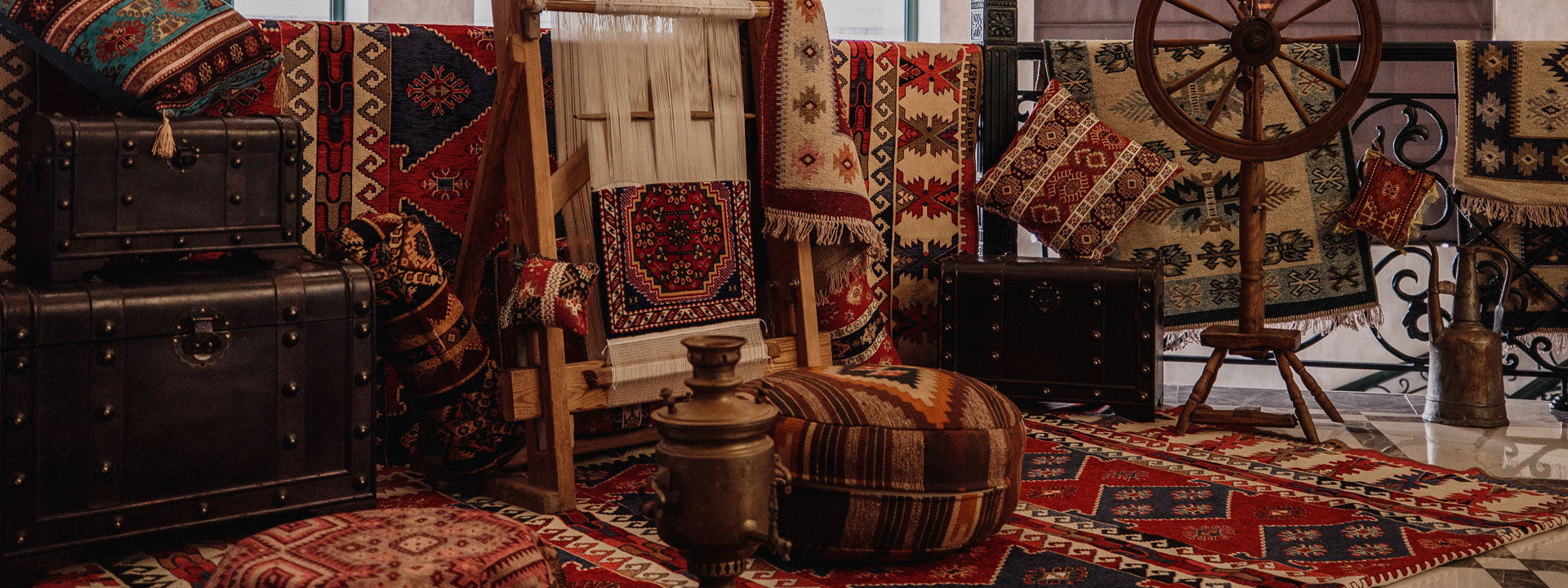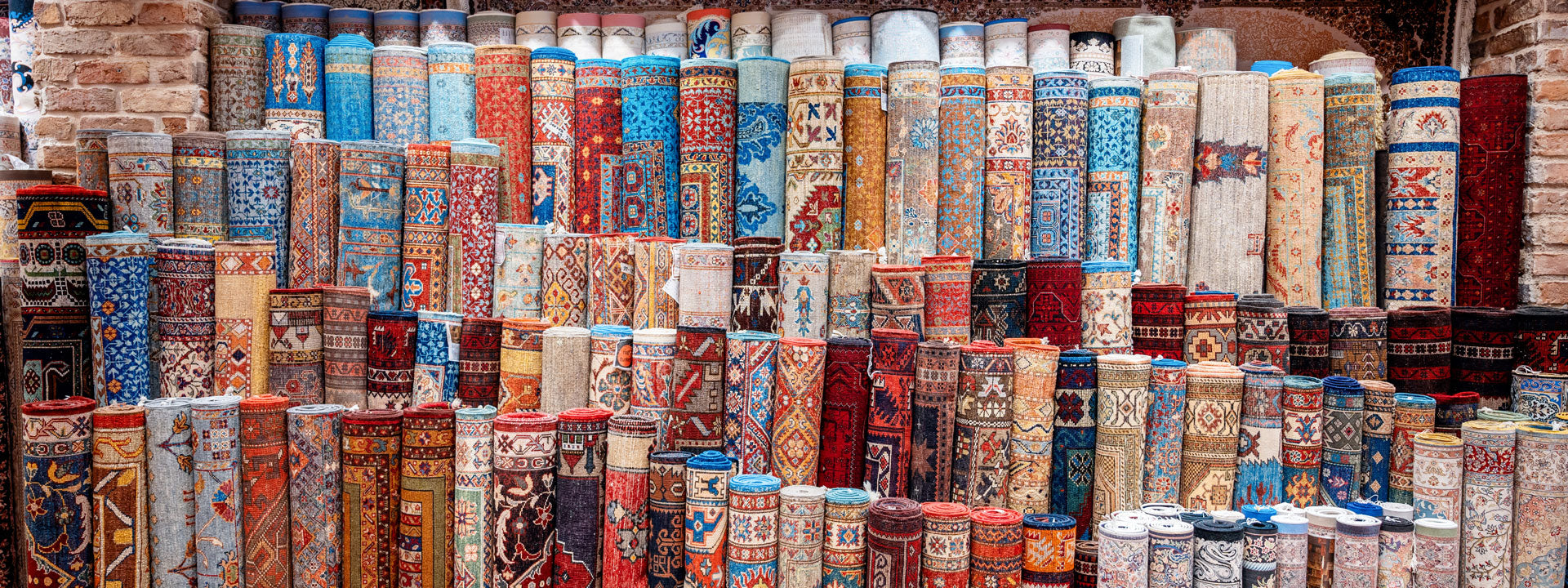
Islam & Oriental Rugs
, by Natalia Rugs , 11 min reading time

, by Natalia Rugs , 11 min reading time
Key events shaped the carpet industry, notably the spread of Islam and Islamic art. This era birthed stunning patterns and colors in carpets, especially in Persian designs, deeply influenced by Islamic traditions 🇮🇷.
Islamic Art: Essence and Evolution
Islamic art, transcending time and geography, embodies the artistic styles born from the Islamic world, deeply rooted in Islam's teachings. It's a diverse tapestry of forms - architecture, calligraphy, painting, ceramics, textiles, and metalwork. This art form thrives beyond a single region or era, evolving over centuries across Islamic-practiced areas.
Key Traits of Islamic Art:
Islamic art, a confluence of various cultures - Persian, Byzantine, Central Asian, and Indian - mirrors the cultural and religious ethos of the Islamic world, blending geometric beauty, calligraphic elegance, and diverse art forms into spiritually resonant and visually captivating creations .

The Beginnings of Islam and the Islamic World
Islam originated in the Arabian Peninsula and, over centuries, expanded across Spain, the Byzantine Empire, the Sasanian Empire, and into Asia. "The Islamic world" encompasses nations where Islam is practiced by rulers and the populace. While there's no strict criterion for its boundaries, this world has historically fluctuated in its reach.
Antique Islamic Carpets and Cultural Impact
The spread of Islam significantly influenced local cultures and politics in new regions. This impact extended to all societal aspects, including the arts. Antique Islamic carpets are a testament to this influence, reflecting the intricate blend of Islamic and local artistic traditions.

Islamic Art as a Cultural Expression
Islamic art is more than a mere display of faith; it's a vibrant way of life. Art enthusiasts recognize four key elements in Islamic art: calligraphy, vegetative patterns, figurative representation, and geometric patterns. While deeply rooted in Islamic faith, this art form boasts a rich diversity and unique personality, evolving over time.
Distinguished Muslim Art
Islamic art, especially in the Middle East, is renowned for its distinct style. It's not just about religious expression but has evolved into a cultural and linguistic identity. This art, reflected in architecture and other forms, showcases unique artistic flavors and innovations.
Influences on Islamic Arts
The artistry under the Sasanian and Byzantine empires significantly influenced Islamic art. Indigenous styles blended with Muslim patronage, creating a unique fusion. This is evident in decorative themes and techniques that combine classical elements with Iranian motifs. Religious monuments, like the Dome of the Rock in Jerusalem, exemplify this blend.
Umayyad Caliphate's Contribution
The Umayyads, borrowing architectural techniques from the Byzantines, left a significant mark on Islamic architecture. The Dome of the Rock, the oldest surviving Islamic building, exemplifies their innovative approach to architecture and artistic expression.
Diversity Across Dynasties
Islamic art is diverse, influenced by various dynasties like the Ottomans, Safavids, and Mughals. Each dynasty contributed its unique style, adding to the rich tapestry of Islamic art. This diversity allows for a fascinating exploration of regional and national styles, showcasing the art's evolution over time.
In summary, Islamic art and rugs represent a deep intertwining of religious, cultural, and artistic expressions, evolving through influences, dynasties, and regional styles to form a unique and diverse artistic legacy.
New Islamic Carpet Patterns Under Islamic Rule
With the advent of Islamic rule, carpet designs underwent a significant transformation, mirroring the artistic evolution in the Islamic world.
Influence of Architecture on Carpet Patterns
Oriental rugs began to incorporate the geometric patterns prevalent in Islamic architecture. This led to the creation of carpets featuring all-over repeated motifs, a stark reflection of the tiled, geometric designs seen in buildings and mosques.
Emergence of the 'Saz' Style
The 'saz' style, characterized by stylized flowers and elegantly curved leaves, also found its way into carpet designs. This style added a new dimension to the traditional patterns, infusing them with a sense of movement and natural elegance.
A Garden of Colors and Shapes
Islamic carpets evolved into a vibrant garden of colors and shapes, showcasing a plethora of floral designs. These included roses, carnations, hyacinths, tulips, lotus flowers, as well as depictions of trees and fruits. This rich diversity in design elements turned carpets into tapestries of nature's beauty.
Blend of Secular and Religious Art
While secular art continued to thrive, new forms of religious art were integrated into the local mix of styles. This fusion expanded the design possibilities, influencing carpet production in both urban centers and rural villages.
In essence, under Islamic rule, carpet patterns became a canvas reflecting the broader artistic and cultural shifts in the Islamic world, blending architectural influences, natural motifs, and a mix of secular and religious themes.

An example of a garden Islamic carpets
Inclusion of Calligraphy in Islamic Carpets
The advent of Islam brought a significant addition to carpet design: the integration of calligraphy. Calligraphy in Islamic art is not just writing; it's a stylized artistic expression, transforming words and phrases into visually stunning art. Sometimes, this calligraphy is purely decorative, resembling Arabic script without actual linguistic meaning.
Kufic Border in Antique Shirvan Rugs
In some carpets, calligraphy with real linguistic content includes Quranic verses or poetry. From the 1450s, early forms of calligraphy, particularly in the "Kufic" style, began appearing in carpet borders. These Kufic scripts were later complemented or replaced by floral and 'saz' motifs.
Antique Persian Mashahir Rugs: Calligraphy with Meaning
The inclusion of calligraphy, especially with linguistic meaning, necessitated the production of finely woven Islamic carpets with high knot density. This evolution in carpet-making not only improved quality but also transformed the processes involved. Weavers now needed to follow specific patterns instead of relying solely on memory, marking a formalization in the artistic creation of carpets.
Impact on Weaving Practices
This shift led to the establishment of schools and weaving workshops, where design and weaving techniques were taught for creating exquisite Court carpets. These institutions played a crucial role in preserving and enhancing the art of carpet weaving, ensuring the transmission of skills and designs through generations.
In summary, the integration of calligraphy into Islamic carpets represents a blend of artistic expression and technical advancement, contributing to the rich legacy and sophistication of Islamic carpet-making.

Islamic border of an antique rug

Introduction of Islamic Prayer Rugs
The advent of Muslim rule heralded a significant innovation in carpet weaving: the Islamic prayer rug. Essential for the five daily prayers mandated in Islam, these rugs have become a cornerstone of Islamic culture and religious practice.
Muslim Prayer Rug
Prayer rugs are designed for individual use, providing a clean and sanctified space for prayers, especially when a mosque is not accessible. Their small, portable size makes them convenient for carrying and use in various settings.
Design and Symbolism
A key feature of these rugs is the mihrab, or prayer niche design, symbolizing the mosque. The mihrab typically includes a base and a minaret-like design at the top, echoing the structure where the call to prayer is made. When in use, the top of the rug is oriented towards Mecca, as all Muslims must know the direction of Mecca for their prayers.
Mihrab Design in Antique Prayer Rugs
Islamic prayer rugs are often intricately designed, featuring ornate patterns that may include floral motifs, geometric shapes, and occasionally, rare pictorial scenes. These designs are reflective of mosque architecture, often incorporating elements like columns and arches. The rugs are not only functional but also artistic representations of sacred spaces.
Preservation and Significance
After prayers, these rugs are rolled up and treated with reverence, akin to sacred objects. This respectful handling has resulted in a greater preservation of antique Islamic prayer rugs compared to other rug types. These rugs are not just functional items but are imbued with religious significance, representing the devoutness and artistic heritage of the Islamic faith.
In essence, Islamic prayer rugs are a beautiful amalgamation of religious function, artistic expression, and cultural significance, deeply embedded in the daily life and spiritual practices of Muslims.

Muslim Prayer Rug
Here are the images showcasing a Mihrab design, highlighted to emphasize its significance in Islamic art.

Praying on an Islamic prayer Rug
Representation of Plants and Animals in Islamic Art
The representation of living beings in Islamic art, including carpets, is a nuanced subject, influenced by varying interpretations of Islamic tenets and local customs.
Orthodox Prohibitions and Artistic Interpretations
Some orthodox Islamic orders prohibit the depiction of "graven" images, including plants, animals, and humans. Despite this, historical carpets from regions under Islamic influence often feature such depictions. The adherence to these prohibitions varied, heavily influenced by the attitudes of local rulers and the prevailing cultural norms.
Abstractions as a Form of Adherence
In some regions, artists abstracted the forms of plants, animals, and humans to adhere to the prohibition against representational images. This approach was acceptable in certain areas, while others deemed it inappropriate. These abstractions, however, spurred the development of new art forms and motifs, adding to the diversity of Islamic art.
Influence of Islam on Art Design
The impact of Islam on art design was not uniform across different regions over its 1400-year history. Representational depictions, especially of plants and animals, are rare in objects intended for religious purposes. In contrast, secular art in the Islamic world often includes such figures.
Impact on Society and the Arts
The spread of Islam brought significant changes in all societal aspects, including the arts. The degree of these changes depended on the orthodoxy of local rulers. The introduction of Islam led to an expansion in the arts, introducing new tools, techniques, and motifs. In many regions, this transformation elevated carpet weaving from a cottage industry to the esteemed status of fine art it holds today.
In summary, the representation of living beings in Islamic art reflects a complex interplay of religious doctrine, artistic innovation, and cultural diversity, contributing to the rich tapestry of Islamic artistic heritage.

S.Barretto
Credits: Wikipedia, Islam Scholar Board, Islamic Carpet Society.


